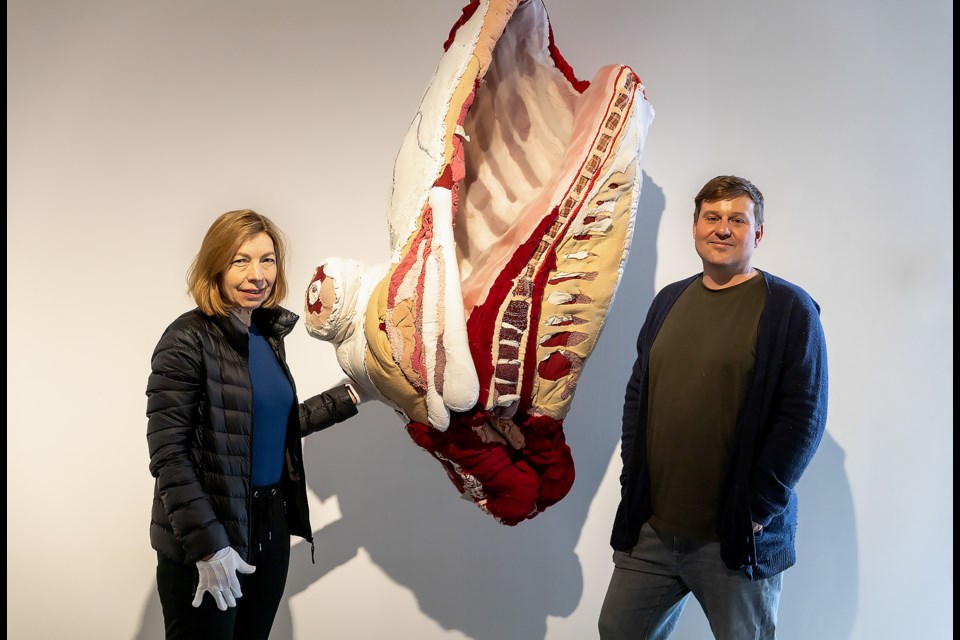BANFF – With spring here and showing its face through the snowstorms, the Whyte Museum of the Canadian Rockies has three new exhibits.
The exhibits, while all different from one another, share a similar likeness through their ties to nature.
Menagerie of Disappearance is a collaboration between four artists who explore a narrative on the human relationship with animals.
Adjacent to the four artists is Ilana Manolson who paints, by memory, abstract landscapes that reflect her experiences and observations in the Canadian Rocky Mountains. The exhibit is aptly titled Time: In the Mountains.
“She has been coming to the Rockies, Lake O’Hara region for many years hiking and these landscapes are all about her time in the mountains. And the ever the ever-flowing nature of the mountains,” said Anne Ewen, the Whyte Museum’s director and chief curator of art and heritage.
Her work expresses vibrant colours and strokes of paint that look like they are flowing on the canvas.
On Friday (April 12) at 7 p.m. the museum will be hosting the opening for Menagerie of Disappearance and Time: In the Mountains.
Lastly, curated entirely from the Whyte Museum’s permanent collection is Nature’s Tiny Muse, which brings together dozens of pieces from different parts of the world that feature insects in various mediums and styles. This exhibit is already open for viewing.
All three exhibits will remain open until June 2.
‘Animals exist all around us, and yet they remain invisible’
In the Menagerie of Disappearance, the four artists – Eva Brandl, Jude Griebel, Tamara Kostianovsky and Lorraine Simms – carry out their narrative through sculptures, textiles, drawings and photographs.
“Animals exist all around us and yet they remain invisible to a certain extent,” said Simms. “I think people should have a chance to reflect a little bit on their place within our world.”
Brandl shares three large photographs of taxidermized raptors to showcase the “western idea” of taking birds and displaying them.
“It’s really kind of an investigation of that whole western idea of removing animals from their habitat and then placing them in these kinds of surreal instances and then using them for display and study,” said Simms.
Using one of the taxidermized owls’ picture by Brandl, Simms overlapped their work and immortalized the bird shadow by tracing and carefully shading it on a canvas with graphite.
With the design idea, Simms drew the shadows of three threatened animals’ different animals, the polar bear, the walrus and the pronghorn antelope, which is native to Alberta.
“When I did my first drawing, I realized that became a very powerful metaphor for extinction for the idea that the animal was there, but not there,” said Simms.
She was able to acquire the bones of the animals during her two research residencies at the American Museum of Natural History in New York City.
Moving into the three-dimensional world, Griebel and Kostianovsky share their perspective on the theme using sculptures.
Kostianovsky uses textile sculptures of butchered animals to form a similarity between consumerism, fast fashion and the human relationship with animals.
“She makes these amazing sculptures of sides of beef, like animals that we habitually consume. And they’re all made out of upcycled fabric … that she collects from thrift stores,” said Simms.
Griebels highlights hundreds of sculpted animals stacked on top of each other in his three sculptures to bring visualization to the depletion of animals “being wiped out due to industrialization and threatened ecosystems”.
“When we hear about and when we read articles about species depletion and all these various lives being wiped out due to industrialization and threatened ecosystems, we never really visualize the full weight of that,” said Greibels.
“The ones I’m showing here, one column is various North American species, so it’s really interesting to show it here in the park.”
He not only puts to light the lives of wild animals, but also the highly consumed factory-farmed animals.
“Usually when we end up seeing them, they’re on a piece of Styrofoam wrapped in plastic, ready for our consumption and they’re lives that often go unacknowledged, although they’re sustaining us all the time,” said Griebels.
‘Nature’s Little Muse’
Using the Whyte Museum’s existing collection, a new exhibit that showcases insects in art has come to light.
“I think it was just kind of fun getting a theme and finding what’s in our collection and pulling it together. And we have such an amazing collection to pick from,” said D.L. Cameron, curator at the Whyte Museum.
The exhibit features small figurines, framed artworks, a diorama of a Japanese insect store, kitchenware, a purse and photographs, which all feature insects.
“This is the bug shop, so they would sell insects and then you would basically raise your insect, you feed it until it died and then go out and find another one,” said Cameron, while pointing to the diorama.
One piece from Japan is dated between 1753 and 1824 and features a parade of silk origami bugs, which Cameron said is one of her favourite pieces in the museum.
“There’s just some pretty interesting and beautiful things about bugs,” said Cameron.
Peter and Catherine Whyte also have one of their pieces hung on the wall.
“The catalyst was I saw this, and it’s not in the show, but I saw this mandala that was done, and it was all beetles. It was really cool,” said Cameron.




